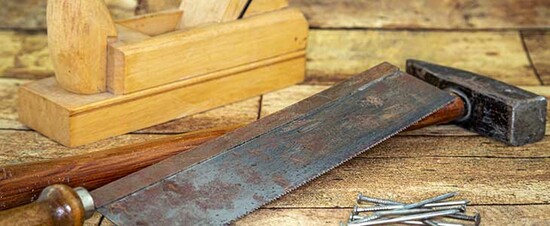When evaluating an antique hand tool, aim to find out as much as you can about its provenance - who owned it? Was it used in a specific trade or profession? Is there any historical significance attached? Recording such details not only helps to add interest and context to your collection but will also help you better understand the purpose of each item.
In terms of condition, well-preserved tools with little wear or damage should be given preference over those that show signs of significant use or abuse. Some rust may also reduce the value - especially if it has eaten away too much metal - so make sure that any tool you purchase has been adequately cleaned up beforehand (this includes regular oiling).
Additionally, always look out for makers' marks which help identify a particular smith or manufacturer, this information can then be used to research further information about them such as when they were in operation etc. Don’t forget - collect what you love! Antique hand tools provide a great insight into our industrial past yet, fortunately, remain accessible enough for anyone with an interest in history or craftsmen/women's skills to appreciate them fully.
Wrenches
Wrenches and adjustable wrenches are invaluable tools for collectors, as they haven't changed much in form or function over the years. Collectable wrenches often feature rare cutout designs on their handles, particularly those made prior to the twentieth century. It is also possible to find wrenches with multiple heads on one handle - a precursor to the modern adjustable wrench - which can be highly sought after by collectors due to the rarity of such pieces.
The wooden handles of some adjustable wrenches can be particularly sought after by collectors due to their aesthetic qualities and potential age, as many antique wooden handled tools were produced prior to the 20th century. The condition of the wooden handle can indicate its originality and value, a handle that appears worn but still sturdy may indicate a higher level of authenticity than one that appears brand new or has obvious signs of repair.
In addition, certain types of wood used in production could provide information about the tool's manufacturing date and origin. For instance, mahogany antiques from Europe may have been crafted in the early 1700s, while walnut was commonly used by American makers during this time period as well.
It is also important for collectors to consider markings that may appear on older wrenches, as these can help identify who made them and when they were crafted. These markings could include company logos, names, or even patent numbers stamped onto the metal parts of the wrench. Even if there are no visible markings present, it is possible to learn more about a particular piece by researching its design and other details such as size and materials used in production. Finally, it's always advisable for collectors to take necessary precautions when handling valuable antique hand tools like wrenches; use gloves when necessary and never attempt repairs yourself without proper training and experience.
Clamps
Antique clamps come in a variety of styles, each with its own unique use and history. The most commonly collected type of clamp is the "bird" style clamp which includes a pincushion mounted on top, and was originally used for sewing. These clamps are renowned for their craftsmanship, often featuring intricate carvings on the wooden handles and beautiful brass detailing.
Vise clamps were traditionally used to hold objects in place when working with metalworking tools or woodworking tools such as chisels, planes, or saws. They typically feature two long arms with a pivot point at the centre that can be adjusted to fit different-sized objects. These clamps were usually made from cast iron or steel, making them very strong and durable.
Blacksmith bench clamps are similar to vise clamps but are designed specifically for blacksmithing operations. These clamps usually have a flat base that sits flush against the anvil or workbench and features two arms with hardened steel tips that can be adjusted to accommodate different sizes of materials. They are incredibly strong and sturdy, able to securely hold hot metals in place while they are being worked on.
Jeweler clamps are another popular antique clamp style used by jewelry makers and watchmakers alike. Unlike other types of clamps, these smaller versions feature specialized jaws designed to grip delicate items without causing any damage to the surface of the material being worked on. These clamps were often made from brass or bronze for extra durability as well as better corrosion resistance.
Picture framing vises also make great collectable items for those interested in antique hand tools. These heavy-duty vises feature three large arms connected at the center with an adjustable screw that allows it to securely hold large frames in place while they are being built or repaired. Picture-framing vises are usually constructed out of cast iron for added strength and stability making them perfect for handling heavier frames with ease.
Rules
Before the measuring tape, rulers were extremely important to carpenters and builders. These long rules frequently featured a folding design, allowing for much easier transport and storage compared to rigid rulers. One such example of a folding ruler is Stanley's zig-zag rule, which folds in 15 places. This design is particularly collectable due to its intricate folding pattern and unique construction.
Other collectable rulers include those that combine other tools such as compasses, levels or squares into a single unit. Cruising sticks with a brass tab at one end are also sought after by collectors due to their relative scarcity and usefulness in carpentry work. These cruising sticks were typically used for determining distances between two points that were not easily measured using traditional methods.
Collectors should also look out for specially manufactured antique rulers featuring special engravings or markings, which could increase the value of the tool depending on age and rarity. In addition, many antique rulers feature unique materials or constructions that can help distinguish them from modern versions of the same type of tool. For instance, some older rulers may have been crafted from brass or other metals rather than wood or plastic like today's modern equivalents.
Hammers
When it comes to collecting antique hand tools, hammers are a popular item. While the use of hammers hasn't changed much over the years, the material and shape of the hammers have. As such there are many rare, unique and collectable types of hammers on the market today.
Hammers made from a variety of materials such as copper, lead, brass and wood can be sought out for their unique look and overall feel. Copper is highly resilient against corrosion, making it a great choice in materials for metalworking tools that need to stay strong yet flexible over time. Lead was often used to add weight to a hammer allowing it to hit with more force. Brass is both durable and attractive when polished; historically it was used for ornamental pieces like jewelry boxes or decorative nails in furniture designs. Wooden handles provide good grip and shock absorption when working with metal components or soft materials like leather or fabric.
Three-piece hammers were also produced in the past, which had handles that could come apart for easier storage when not in use. Additionally, some antique hammers featured moveable heads or interchangeable heads which allowed users to swap between different functions quickly if needed. A few even featured different types of heads combined into one piece-- like a combination hammer/axe design or hammer/pry bar combination tool-- which could make certain tasks more efficient than ever before!
No matter what type of antique hammer you're after, be sure to do your research first so that you can obtain an authentic item with no structural damage or defects that might compromise its value or usability now and in the future!
Chisels
Antique chisels are available in three broad types: woodworking, carpenters and lathe. Woodworking chisels are designed for general use in carpentry and joinery work, while carpenter's chisels are typically used for more delicate operations such as trimming or shaping pieces of wood. Lathe chisels, meanwhile, are specialized tools meant to be used with a lathe machine to shape wood into intricate shapes such as spindles or balusters.
When searching for antique chisels, look for those with wooden handles or speciality curved blades. Wooden handles are classic and can make the tool easier to handle, but they may require regular maintenance such as oiling to keep them from drying out. Blades that feature curves or other unique shapes may have been made specifically for certain tasks - look for these if you need a speciality job done. It's also important to inspect the blade itself; check that it isn't too worn down and that it remains sharp enough to be effectively used.
In addition to the shape and type of handle, consider the size of the chisel when selecting one. A smaller tool may be better suited to fine detail work while larger sizes are better at heavy-duty tasks like chopping through hardwoods. If you're unsure of what size is right for your project, it's best to try out a few different sizes before committing to one option. Also, take into account any additional features the tool might have – some come with a guard at the bottom of the handle or have an adjustable mouth which can help prevent injuries due to slips or misdirection during use.


Comments
There are no comments yet. Login or Register and write an article comment